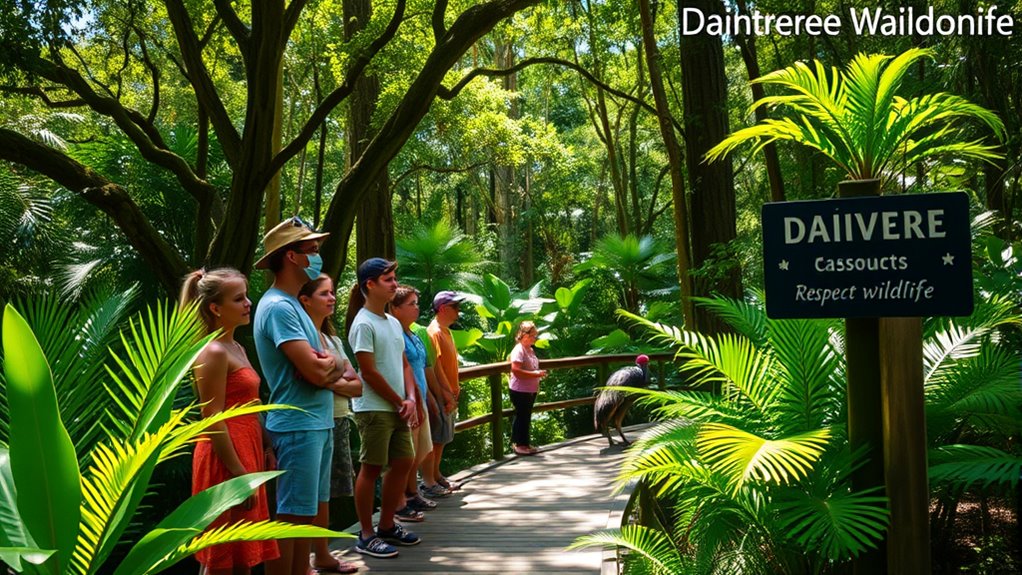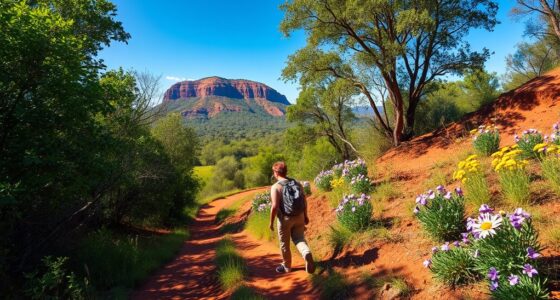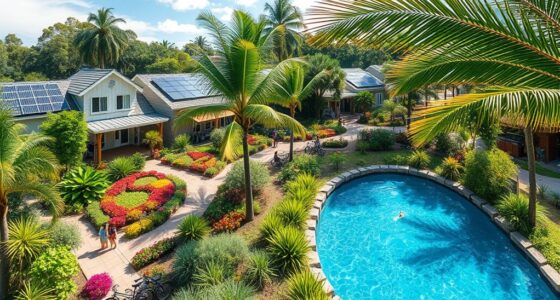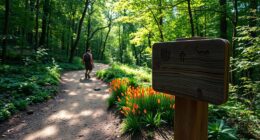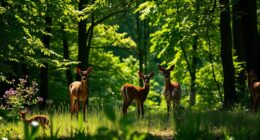When observing wildlife in the Daintree Rainforest, keep a safe distance to avoid stressing the animals. Stick to marked paths to protect fragile ecosystems and always use natural light for photography—no flash! Stay quiet and patient during encounters to truly connect with the wildlife. Practice responsible sharing of your experiences, promoting conservation in your posts. For more tips on how to enhance your wildlife viewing experience while helping to protect this stunning environment, just keep exploring!
Key Takeaways
- Maintain a safe distance from wildlife to reduce stress and allow animals to behave naturally.
- Stay on designated paths to protect fragile ecosystems and minimize environmental impact.
- Avoid using flash photography; rely on natural light for capturing images without disturbing animals.
- Remain patient and quiet during encounters to increase your chances of observing wildlife.
- Share content responsibly online, promoting conservation and eco-friendly practices.
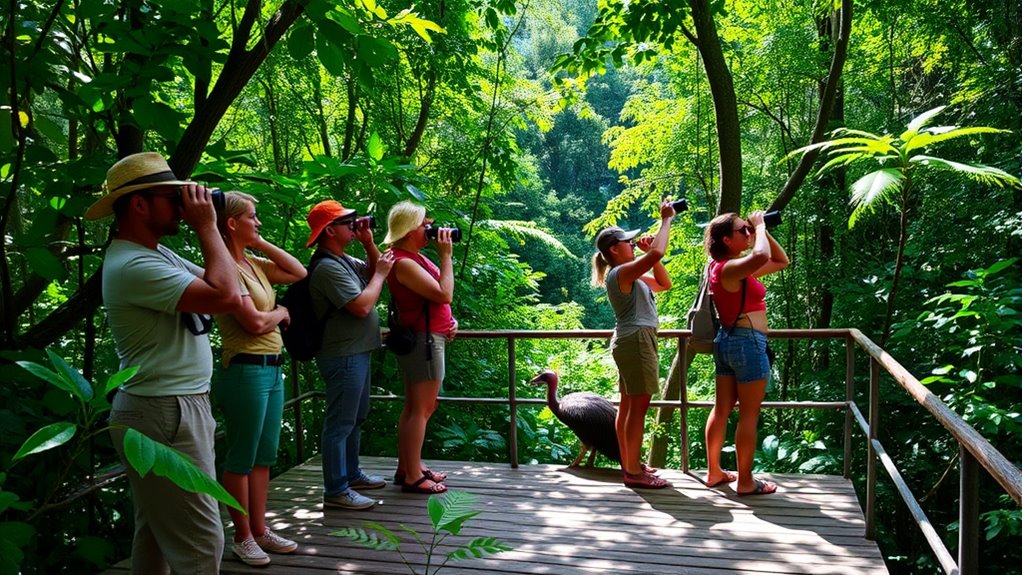
When you venture into the Daintree Rainforest, it’s essential to respect the delicate balance of this unique ecosystem. This ancient rainforest is home to a stunning array of wildlife, which makes it a paradise for wildlife photography. However, capturing that perfect shot shouldn’t come at the expense of the animals or their habitat. By following some simple etiquette guidelines, you can enjoy your experience while ensuring the well-being of the environment.
First, keep your distance. It might be tempting to get up close for that stunning photograph, but many animals need their space. Approaching too closely can stress them out or disrupt their natural behaviors. Instead, use a zoom lens to capture images from a safe distance. This way, you can document the beauty of the creatures without imposing on their territory. Remember, the goal is to observe and appreciate, not to intrude.
Next, stick to designated paths. The Daintree is fragile, and wandering off the trails can damage the delicate flora and fauna. By staying on marked paths, you minimize your impact on the environment. This is a key component of eco-friendly practices. It’s important to leave no trace and ensure that future visitors can enjoy the same breathtaking sights you did.
When photographing wildlife, avoid using flash. Flash photography can startle animals and alter their behavior. Instead, make use of natural light to create stunning images. You’ll find that the soft, diffused light of the rainforest can produce beautiful effects that enhance your photos without the need to disturb the wildlife.
If you encounter wildlife, be patient and quiet. Sudden movements or loud noises can frighten animals away. Instead, take a moment to observe their behavior, allowing yourself to be immersed in the experience. This not only increases your chances of getting that perfect shot but also enriches your connection to nature.
Lastly, share your experiences responsibly. When posting your wildlife photography online, consider the impact of your words and images. Promote eco-friendly practices and educate your audience about the importance of conservation. This way, you contribute to the preservation of the Daintree and inspire others to appreciate and protect this remarkable ecosystem. Additionally, understanding the role of natural habitats is crucial for wildlife conservation efforts in these areas.
Frequently Asked Questions
What Time of Day Is Best for Wildlife Viewing in Daintree?
The best time for wildlife viewing in Daintree is during the early morning or late afternoon. In the morning light, you’ll spot active creatures as they search for food. As the day cools, evening activity ramps up, making it another prime time for sightings. So, whether you’re enjoying the dawn chorus or watching animals come alive at dusk, you’re in for an unforgettable experience. Don’t forget your camera!
Are There Specific Trails Recommended for Wildlife Sightings?
Did you know that over 400 species of wildlife thrive in the Daintree Rainforest? For the best sightings, consider the Mossman Gorge and the Jindalba Boardwalk trails. Both offer moderate trail difficulty, making them accessible yet rewarding. If you want a more informative experience, guided tours are available, providing expert insight into the unique flora and fauna. You’ll enhance your wildlife viewing while exploring this incredible ecosystem.
Can I Bring Food While Wildlife Viewing?
You can bring food while wildlife viewing, but it’s important to be responsible. Avoid feeding animals, as this can disrupt their natural behavior and diet. Always dispose of your litter properly; use designated bins to keep the area clean and safe for wildlife. Remember, your actions can impact the environment, so enjoy your snacks responsibly and respect the natural habitat around you. Keeping the area pristine guarantees a better experience for everyone.
How Can I Photograph Wildlife Without Disturbing Them?
To capture enchanting critters, practice patience and precision. Start by observing wildlife from a distance, allowing them to act naturally. Use a zoom lens to frame your shots without intruding on their space. Embrace ethical photography by respecting their habitat; avoid flash and sudden movements. Remember, the heart of wildlife patience lies in letting animals be themselves. With time, you’ll snap stunning shots that honor their world while showcasing your skills beautifully.
Are There Any Seasonal Wildlife Patterns to Consider?
Yes, there are seasonal wildlife patterns to take into account. During certain times of the year, you’ll notice seasonal migration, as many animals travel to find food or breeding grounds. Pay attention to breeding seasons too; they often bring increased activity as animals search for mates and raise their young. Understanding these patterns will enhance your wildlife viewing experience, allowing you to witness the natural behaviors and cycles of the creatures you encounter.
Conclusion
As you wander through the enchanting Daintree Rainforest, remember that each creature you encounter is a essential thread in this intricate tapestry of life. By practicing respectful wildlife viewing, you honor not just their existence but also the delicate balance of nature. Like the whispers of ancient trees, your actions resonate throughout this magical place. So, tread lightly and observe with kindness—after all, you’re a guest in their home, and every moment shared can spark a deeper connection.

